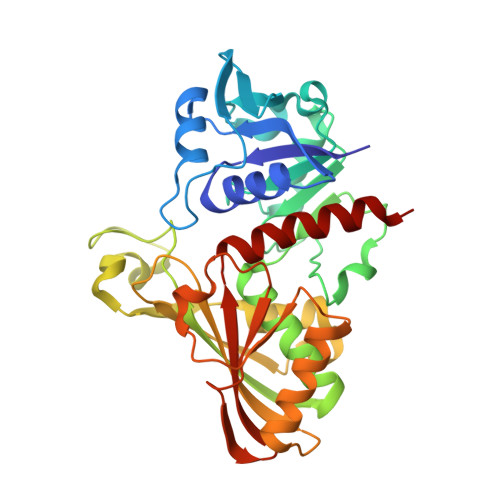Crystal structures of rice (Oryza sativa) glyceraldehyde-3-phosphate dehydrogenase complexes with NAD and sulfate suggest involvement of Phe37 in NAD binding for catalysis
Tien, Y.C., Chuankhayan, P., Huang, Y.C., Chen, C.D., Alikhajeh, J., Chang, S.L., Chen, C.J.(2012) Plant Mol Biol 80: 389-403
- PubMed: 22903596
- DOI: https://doi.org/10.1007/s11103-012-9953-7
- Primary Citation of Related Structures:
3V1Y - PubMed Abstract:
Cytosolic Oryza sativa glyceraldehyde-3-phosphate dehydrogenase (OsGAPDH), the enzyme involved in the ubiquitous glycolysis, catalyzes the oxidative phosphorylation of glyceraldehyde-3-phosphate to 1,3-biphosphoglycerate (BPG) using nicotinamide adenine dinucleotide (NAD) as an electron acceptor. We report crystal structures of OsGAPDH in three conditions of NAD-free, NAD-bound and sulfate-soaked forms to discuss the molecular determinants for coenzyme specificity. The structure of OsGAPDH showed a homotetramer form with each monomer comprising three domains-NAD-binding, catalytic and S-loop domains. NAD binds to each OsGAPDH subunits with some residues forming positively charged grooves that attract sulfate anions, as a simulation of phosphate groups in the product BPG. Phe37 not only forms a bottleneck to improve NAD-binding but also combines with Pro193 and Asp35 as key conserved residues for NAD-specificity in OsGAPDH. The binding of NAD alters the side-chain conformation of Phe37 with a 90° rotation related to the adenine moiety of NAD, concomitant with clamping the active site about 0.6 Å from the "open" to "closed" form, producing an increased affinity specific for NAD. Phe37 exists only in higher organisms, whereas it is replaced by other residues (Thr or Leu) with smaller side chains in lower organisms, which makes a greater distance between Leu34 and NAD of E. coli GAPDH than that between Phe37 and NAD of OsGAPDH. We demonstrated that Phe37 plays a crucial role in stabilizing NAD binding or intermediating of apo-holo transition, resulting in a greater NAD-dependent catalytic efficiency using site-directed mutagenesis. Phe37 might be introduced by evolution generating a catalytic advantage in cytosolic GAPDH.
- Life Science Group, Scientific Research Division, National Synchrotron Radiation Research Center, Hsinchu, Taiwan.
Organizational Affiliation:

















